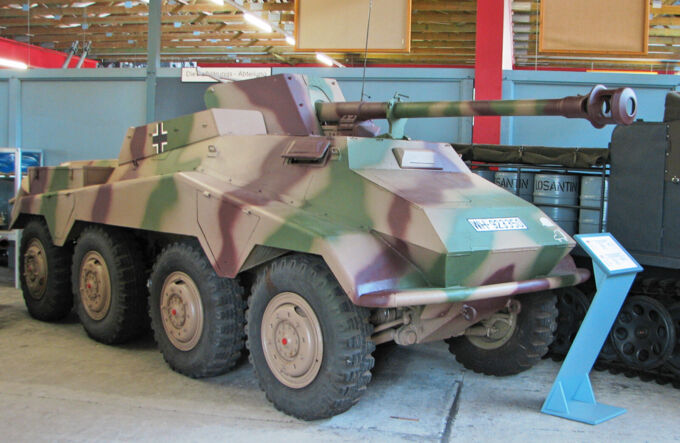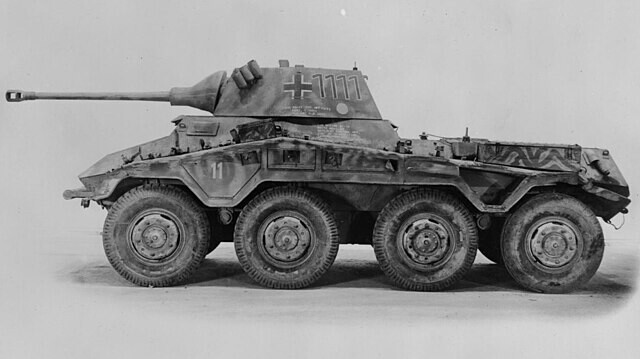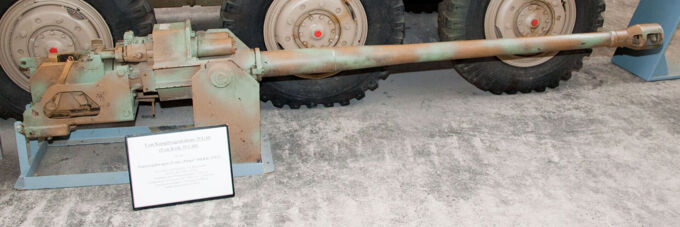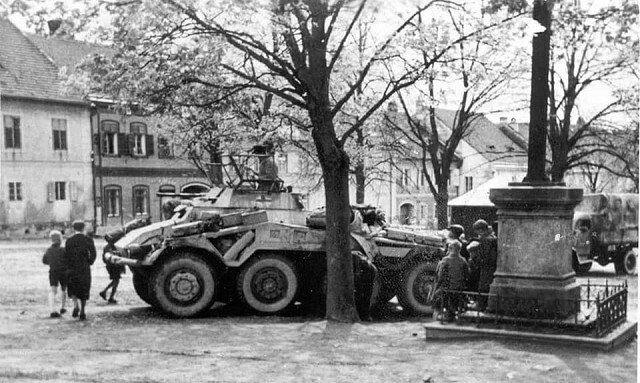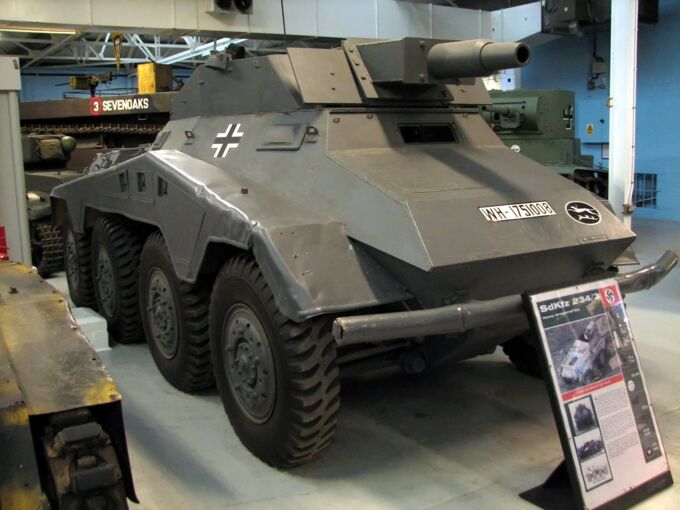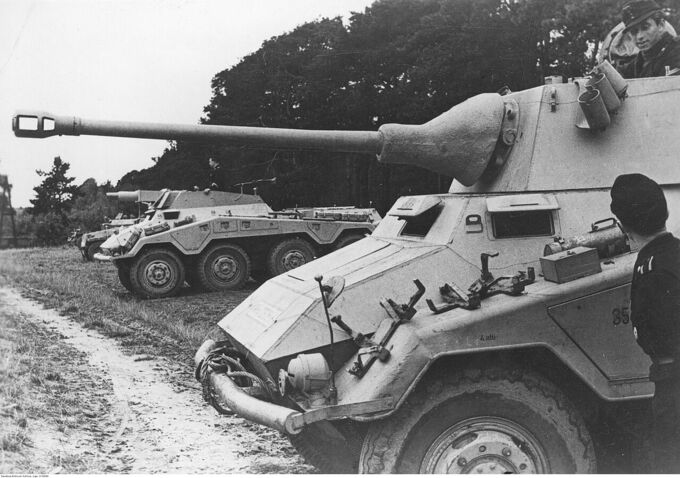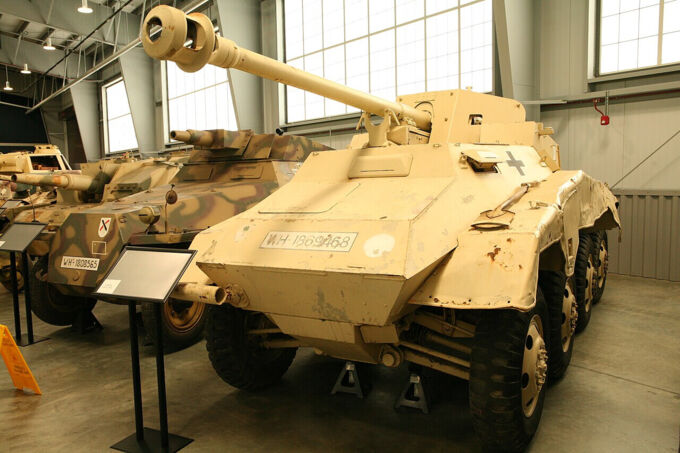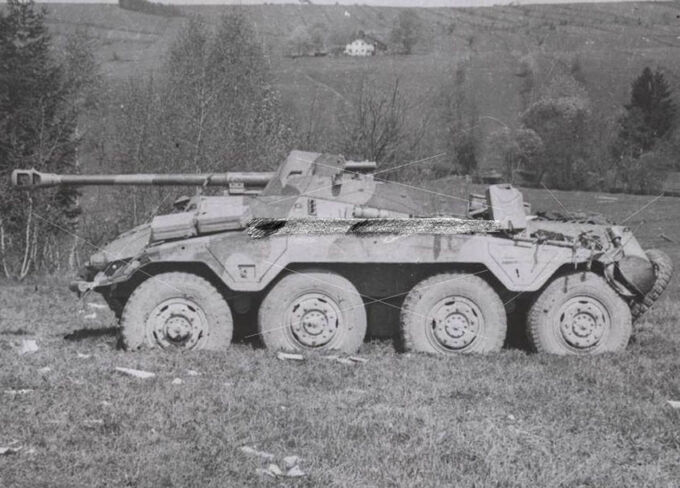This article will explore the development and service history of the Sd.Kfz. 234 heavy armoured car family, which includes the Sd.Kfz. 234/1, 234/2, 234/3, and 234/4. The Sd.Kfz. 234 series were the last to be produced by Germany during the Second World War, and were relatively uncommon. Despite this, they remain some of the most well-known armoured cars of their time.
Early Development
Development of this series of armoured car began on the 5th of August 1940, when Waffen Prüfen 6—the design office of the German Heereswaffenamt—was tasked with designing an armoured car with a similar chassis to the Sd.Kfz. 231 heavy armoured car that would incorporate the following:
- An air-cooled diesel engine, as earlier armoured cars would easily overheat in North Africa;
- Increased fording ability;
- An armoured hull serving as the chassis, instead of a frame—earlier armoured cars were simply armoured bodies on top of a frame;
- Increased superstructure armour (30 mm); and
- Crew compartment ventilation.
Büssing-NAG was chosen to design the chassis and superstructure, while Tatra-Werke was chosen for the engine. The project was designated 8RTp, or 8-Rad Tropen.
The earliest iteration of this project had the following design specifications:
- A weight of 12 metric tons, operated by a crew of four, with a maximum speed of 90 km/h;
- 30 mm thick armour at the front, while other surfaces were just thick enough to block 7.92 mm S.m.K. rounds; and
- Armament consisting of a 2 cm KwK 38 cannon with Flakrohr and a 7.92 mm MG 34 machine gun.
Interestingly, the design of the Sd.Kfz. 234 included a second rear-facing driver seat in addition to the forward-facing one, allowing the vehicle to change directions quickly.
Sd.Kfz. 234/2
Development
The first vehicle—chronologically—in the Sd.Kfz. 234 family was the Schwerer Panzerspähwagen (5 cm), ordnance designation Sd.Kfz. 234/2.
A report on the development of the 8RTp from the 1st of July 1942 listed a design change: the vehicle's armament would instead consist of a 5 cm KwK 39/1 L/60 cannon and a 7.92 mm MG 42 machine gun. On the 3rd of November 1942, the Army High Command's Industrial Armaments Office announced the production of 100 vehicles (Fahrgestell Nr. Series 5001 - 5100) following the new armament specification. These were built between December 1943 and June 1944, now designated as the Sd.Kfz. 234.
Production was delayed between December 1943 and February 1944 due to a shortage of cast armour parts, including the uniquely shaped Topfblende gun mantlet. Notably, the turret fitted was similar—but not entirely identical to—a Daimler-Benz designed turret from an earlier light tank design, the VK 16.02 Leopard. In total, 101 vehicles were built.
The vehicle's designation was only changed to Sd.Kfz. 234/2 in March 1944. Despite being commonly referred to as the Puma, this name was never used, either as a formal designation or as a nickname.
Service History
Slow progress on engine development meant that the Sd.Kfz. 234/2 entered service too late to serve in North Africa, the theatre for which it was originally intended.
The Sd.Kfz. 234/2 was one of the most heavily armed armoured cars of its time. Despite this, its primary purpose remained reconnaissance, and it was organized into 25-vehicle companies known as Panzerspähkompanien. While each vehicle was equipped with radio equipment, only 13 of every 25 vehicles in a Panzerspähkompanie were equipped with the powerful, long-range Fu 12 radio.
Records published in October 1943 and April 1944 show that one full Panzerspähkompanie was assigned both the Panzer Lehr Division and the 2nd Panzer Division, while the 1st SS Panzer Division and 20th Panzer Division were each assigned 16 vehicles as well. During this period, the 1st SS Panzer, 2nd Panzer, and Panzer Lehr divisions were mainly stationed on the Western Front, while the 20th Panzer Division was stationed on the Eastern Front.
The remaining vehicles out of the 101 produced were allocated to training units or testing by the Heereswaffenamt.
Sd.Kfz. 234/1 and 234/3
Development of the Sd.Kfz. 234/1
The next vehicle to be developed was the Schwerer Panzerspähwagen (2 cm), ordnance designation Sd.Kfz. 234/1.
This vehicle represented the realization of the original armament intended for the 8RTp, armed with a 2 cm KwK 38. The MG 34 specified in the original design was replaced by a MG 42 in this version. Both weapons were mounted on the open-topped Hängelafette 38 mount, which had been developed in 1940.
As with the Sd.Kfz. 234/2, each vehicle was outfitted with radio equipment, but only select vehicles—those operated by a unit or section commander—were outfitted with the long-range Fu 12 radio.
Development of the Sd.Kfz. 234/3
The next vehicle in the family was the Schwerer Panzerspähwagen (7.5 cm), ordnance designation Sd.Kfz. 234/3.
The success of the 7.5 cm Kanone 37 in close-support duties on a previous model of armoured car—the Sd.Kfz. 233—spurred the development of the 7.5 cm Kanone 51, which was standardized and mounted on both the Sd.Kfz. 234 and Sd.Kfz. 251 half-track. The Sd.Kfz. 234/3 carried this weapon on an open-topped, lightly armoured (14.5 mm thick) mount, with an additional MG 42 mounted further back for anti-aircraft purposes.
All vehicles were equipped with radio equipment, though this vehicle notably did not use an intercom set for internal communications, instead relying on speaking tubes. The Sd.Kfz. 234/3 was nearly identical in dimensions and weight to the Sd.Kfz. 234/1.
Production and Service History
In addition to announcing the production of 100 vehicles of the Sd.Kfz. 234/2 on the 3rd of November 1942, the Industrial Armaments Office also announced that the Sd.Kfz. 234/1 and Sd.Kfz. 234/3 would be produced beginning in April, with half of overall production being allocated to each. This ratio was changed to thirteen Sd.Kfz. 234/1 for every three Sd.Kfz. 234/3 in March 1944, and again changed in October 1944 to nine Sd.Kfz. 234/1 for every seven 234/3.
While production of the Sd.Kfz. 234/1 continued to the end of the war in 1945, ultimately totaling approximately 230 vehicles, Sd.Kfz. 234/3 production ended in December 1944 after 90 vehicles had been produced, the remaining chassis being modified for Sd.Kfz. 234/4 production.
Delays in production led to the first deliveries of these vehicles only beginning in June 1944. Thirteen Sd.Kfz. 234/1 and three Sd.Kfz. 234/3 were issued to each of eight divisions: the 116th, 9th, 11th, 6th, 8th, 2nd SS, 9th SS Panzer Divisions, as well as the Panzer Lehr Division. Any remaining vehicles were later allocated to various units intermittently as reinforcements.
The 7.5 cm Kanone 51 of the Sd.Kfz. 234/3 could provide covering fire and engage medium-armoured targets, given its capability of firing shaped-charge rounds in addition to high-explosive rounds. The 2 cm KwK of the Sd.Kfz. 234/1 performed well against lightly armoured and soft targets, but was also found to be especially effective for anti-aircraft purposes, making it the most preferred model in the Sd.Kfz. 234 family, even in the late stages of the war.
Sd.Kfz. 234/4
Development
The final vehicle in the family was the Schwerer Panzerspähwagen (7.5 cm PaK 40), ordnance designation Sd.Kfz. 234/4.
During a meeting with Hitler on the 28th of October 1944, the Generalinspektur der Panzertruppen recorded a proposal for the installation of the 7.5 cm PaK 40 anti-tank gun on the Sd.Kfz. 234 chassis. Despite doubts regarding the technical feasibility of such a concept, Büssing-NAG had already prepared design plans by the 9th of November 1944. Hitler repeatedly expressed his support for the design throughout November and December 1944.
The PaK 40 was mounted on the Sd.Kfz. 234 chassis through a slight modification of the existing Sd.Kfz. 234/3 mount for the Kanone 51.
Production and Service History
Production of the Sd.Kfz. 234/4 began in December 1944 and ended in April 1945, with approximately 90 vehicles produced in total. The Sd.Kfz. 234/4 was primarily issued—like most other remaining examples of the Sd.Kfz. 234—in small amounts to various units as reinforcements and replacements. The firepower of the PaK 40 remained adequate against most Allied armour it encountered, and high-explosive shells allowed it to engage soft targets as well.
Comparative Specifications
| Sd.Kfz. 234/1 | Sd.Kfz. 234/2 | Sd.Kfz. 234/3 | Sd.Kfz. 234/4 | |
|---|---|---|---|---|
| Weight (metric tons, loaded) | 11.5 | 11.7 | 11.5 | ~12 |
| Armament | 2 cm KwK 38, 7.92 mm MG 42 | 5 cm KwK 39/1 L/60, 7.92 mm MG 42 | 7.5 cm K51 L/24, 7.92 mm MG 42 | 7.5 cm PaK 40 |
| Dimensions (m, overall) | 5.86 x 2.33 x 2.10 | 6.80 x 2.33 x 2.38 | 5.86 x 2.33 x 2.213 | unknown x 2.33 x 2.38 |
| Units Produced | ~230 | 101 | 90 | ~90 |
| Date of Introduction | 1 Apr 1944 | 1 Oct 1943 | 1 Apr 1944 | Early Jan 1945 |
Bibliography
- Jentz, Thomas L. Panzer Tracts No. 13 Panzerspaehwagen. Panzer Tracts, 1 Jan. 2001, p. 36-46.
- Jentz, Thomas L. Panzer Tracts No. 20-2, Paper Panzers: Aufklärungs-, Beobachtungs-, and Flak-Panzer (Reconnaissance, Observation, and Anti-Aircraft). Panzer Tracts, 2002, p. 68.
- Jentz, Thomas L. Museum Ordnance Special No. 24: Schwerer Panzerspaehwagen (Sd.Kfz. 234). Darlington Productions, Inc., 1998.
